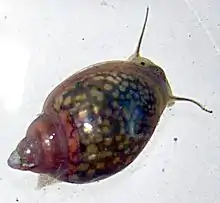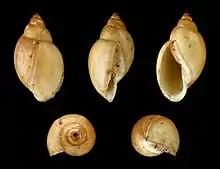Physella acuta
Physella acuta is a species of small, left-handed or sinistral, air-breathing freshwater snail, an aquatic gastropod mollusk in the family Physidae. Common names include European physa, tadpole snail, bladder snail, and acute bladder snail. In addition, Physa acuta, Physa heterostropha (Say, 1817) and Physa integra (Haldeman, 1841) are synonyms of Physella acuta (Draparnaud, 1805).
| Physella acuta | |
|---|---|
 | |
| A live individual of Physella acuta | |
NE[1] | |
| Scientific classification | |
| Kingdom: | |
| Phylum: | |
| Class: | |
| (unranked): | |
| Superfamily: | |
| Family: | |
| Subfamily: | Physinae |
| Tribe: | Physellini |
| Genus: | |
| Species: | P. acuta |
| Binomial name | |
| Physella acuta (Draparnaud, 1805)[2] | |
| Synonyms | |
|
Physa acuta Draparnaud, 1805 | |
Etymology
The etymology of the name Physella is obscure but could be ultimately from a Greek root. "Physella" (as a place name) is recorded in Giovanni Gemisto's printed edition of Pliny's encyclopedia, perhaps lifted from Ermolao Barbaro's Castigationes Plinianae where it is recorded as Physcella.[4] The French naturalist Jacques Draparnaud was the first to describe a species of the genus Physella and coined the name.
Shell description

Snails in the family Physidae have shells that are sinistral, which means that if the shell is held with the aperture facing the observer and the spire pointing up, then the aperture is on the left-hand side.
The shells of Physella species have a long and large aperture, a pointed spire, and no operculum. The shells are thin and corneous and rather transparent.
Distribution
It was once thought that the indigenous distribution of Physella acuta is Mediterranean.[5][6] However, when Physella heterostropha is considered to be a synonym, then the indigenous distribution of the species includes North America.[7]
Physella acuta is a common species which is common in all of North America, Europe and the United Kingdom. The species seems to have first spread through the Mediterranean regions and then more slowly into Northern Europe.[3][7]
In the United Kingdom
Within the United Kingdom, P. acuta is considered to be an invasive species. The "European physa" or "common bladder snail", as it is commonly known in England, is a prolific species that has undergone naturalisation. The European physa has been observed on several great Rivers, streams and tributaries within England, Wales, Scotland and Northern Ireland including the River Severn and the River Thames.[8] The ecological impact of this invasive species to the native floral and faunal species of the United Kingdom was assessed by the United Kingdom Technical Advisory Group (UKTAG) as "Unknown" [9] under the Water Framework Directive guidelines for Alien species.
In Europe
This species is found in:
- Belgium
- Croatia
- Italy
- Czech Republic[10] – not evaluated (NE)[11]
- Slovakia[10]
- Germany[12]
- Netherlands[13]
- Pripyat River since 1983 and in Neman River basin in Belarus since 2007[7]
- Denmark
- and others
The distribution also includes Mediterranean regions and Africa.[14]
In America
The distribution includes the United States: Maryland, New Jersey, Tennessee, and Virginia.[14]
- Cuba – native, also with Tarebia granifera it is the most common freshwater snail in Cuba[15]
Ecology
Habitat
This species lives in freshwater rivers, streams, lakes, ponds, and swamps.[14]
Physella acuta is frequently found in anthropogenic reservoirs, occurring in warm water discharges from power stations and in some rivers, but very rarely and not numerously in clay pit ponds. It can survive well under temporary harsh conditions (extreme temperature and water pollution), as long as they are short-lived.[7]
Feeding habits
These snails eat dead plant and animal matter and various other detritus.
Because Physella acuta forages mainly on epiphytic vegetation and on the macrophytes, whereas other gastropods (Planorbis planorbis, Radix ovata) exploit the algal cover or phytobentos on the bottom, competition between Physella acuta and other gastropods appears to be minimal.[7]
Interspecific relationship
This species successfully co-exists with other alien gastropods: for example with Potamopyrgus antipodarum in many streams, lakes and ponds in New Zealand and with Lithoglyphus naticoides in the Danube River.[7] Within the United Kingdom, this species has also been to observed to coexits with Jenkins' Spire-Snail (Potamopyrgus antipodarum) in many aquatic habitats. The presence of the European physa may encourage proliferation of invasive non-native macrophytes such as Nuttall's waterweed (''Elodea nuttallii'')
References
This article incorporates CC-BY-2.0 text (but not under GFDL) from reference.[7]
- 2006 IUCN Red List of Threatened Species. <www.iucnredlist.org>. Cited 30 April 2007.
- Draparnaud J.-P.-R. 1805. Histoire naturelle des mollusques terrestres et fluviatiles de la France. Ouvrage posthume. Avec XIII planches. pp. [1-9], j-viij [= 1-8], 1-134, [Plates 1-13]. Paris, Montpellier. (Plassan, Renaud).
- Dillon R. T., Wethington A. R., Rhett J. M. & Smith T. P. 2002. Populations of the European freshwater pulmonate Physa acuta are not reproductively isolated from American Physa heterostopha or Physa integra. Invertebrate Biology, 121: 226-234. (abstract)
- Greece Reinvented: Transformations of Byzantine Hellenism in Renaissance Italy by Han Lamers
- (in Slovak) Lisický M. J. (1991). Mollusca Slovenska [The Slovak molluscs]. VEDA vydavateľstvo Slovenskej akadémie vied, Bratislava, 344 pp.
- Glöer, P. 2002 Die Süßwassergastropoden Nord- und Mitteleuropas. Die Tierwelt Deutschlands, ConchBooks, Hackenheim, 326 pp., ISBN 3-925919-60-0, page 238-239.
- Vitaliy Semenchenko, Tatiana Laenko & Vladimir Razlutskij. 2008. A new record of the North American gastropod Physella acuta (Draparnaud 1805) from the Neman River Basin, Belarus. Aquatic Invasions (2008) Volume 3, Issue 3: 359–360.
- https://species.nbnatlas.org/species/NHMSYS0001702159
- http://www.nonnativespecies.org/factsheet/factsheet.cfm?speciesId=2674
- (in Czech) Horsák M., Juřičková L., Beran L., Čejka T. & Dvořák L. (2010). "Komentovaný seznam měkkýšů zjištěných ve volné přírodě České a Slovenské republiky. [Annotated list of mollusc species recorded outdoors in the Czech and Slovak Republics]". Malacologica Bohemoslovaca, Suppl. 1: 1–37. PDF.
- Beran, L. (2002) Vodní měkkýši České Republiky – rozšíření a jeho změny, stanoviště, šíření, ohrožení a ochrana, červený seznam. Aquatic molluscs of the Czech Republic – distribution and its changes, habitats, dispersal, threat and protection, Red List. – Sborník přírodovědného klubu v Uherském Hradišti, Supplementum 10, 258 pp. (in Czech)
- MollBase – Physella acuta – Spitze Blasenschnecke – Atlas 1991
- "Physella acuta". 2005.
- Amy Benson. 2007. Physella acuta. USGS Nonindigenous Aquatic Species Database, Gainesville, FL. https://nas.er.usgs.gov/queries/FactSheet.asp?speciesID=1025 Revision Date: 4/22/2004
- Vázquez A. A. & Perera S. (2010). "Endemic Freshwater molluscs of Cuba and their conservation status". Tropical Conservation Science 3(2): 190–199. HTM, PDF.
Further reading
- Naranjo-García E. & Appleton C. C. (2009). "The architecture of the physid musculature of Physa acuta Draparnaud, 1805 (Gastropoda: Physidae)". African Invertebrates 50(1): 1-11. Abstract
External links
- Physa acuta at AnimalBase taxonomy,short description, distribution, biology,status (threats), images
- https://web.archive.org/web/20071007012447/http://www.aquarium-kosmos.de/inhalt/50/blasenschnecken-physella-acuta